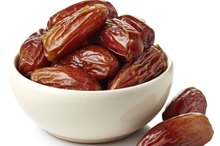What does fact checked mean?
At Healthfully, we strive to deliver objective content that is accurate and up-to-date. Our team periodically reviews articles in order to ensure content quality. The sources cited below consist of evidence from peer-reviewed journals, prominent medical organizations, academic associations, and government data.
The information contained on this site is for informational purposes only, and should not be used as a substitute for the advice of a professional health care provider. Please check with the appropriate physician regarding health questions and concerns. Although we strive to deliver accurate and up-to-date information, no guarantee to that effect is made.
Bitter Gourd for Kidney Stones
If you have kidney stones, you may experience pain in your back or abdomen, bloody urine, vomiting or fevers. Some of the characteristics of bitter gourd, also known as balsam-pear or Momordica charantia, may lower your risk for developing kidney stones. Ask your doctor or nutritionist whether you should include it in a balanced diet for preventing stones or relieving symptoms.
Most kidney stones are hardened formations of calcium phosphate or calcium oxalate. Even if you are lucky enough that your kidney stones pass without symptoms, your risk for developing kidney stones is higher if you already have a history of stones, according to the Langone Medical Center. Other risk factors are a family history, being a male age 20 to 50, being pregnant, and becoming dehydrated. Proper nutrition can lower your risk for more stones, and bitter gourd can help you stick to recommendations.
Weight Control
Bitter gourd can be beneficial to the kidneys if you use it to control weight, since your chance of developing stones increases if you are obese, according to the Langone Medical Center. Each raw bitter gourd or balsam-pear pod has only 21 calories in a 124-g or 4.4-oz. serving. Since bitter gourd and most other fresh vegetables are low in calories, you can fill up on them without going over your calorie limit.
- Bitter gourd can be beneficial to the kidneys if you use it to control weight, since your chance of developing stones increases if you are obese, according to the Langone Medical Center.
Dietary Fiber and Sodium
Date Fruits & Kidney Stones
Learn More
A bitter gourd pod provides 3.5 g dietary fiber, or 14 percent of the daily value, and only 6 mg sodium, or less than 1 percent of the daily value for sodium. A high-fiber, low-sodium diet may help you prevent kidney stones, according to the Mayo Clinic. Dietary fiber comes from the parts of plant foods the body cannot digest, and other potential benefits include preventing constipation and controlling blood sugar. Limiting sodium intake is also beneficial in that it helps to control blood pressure, according to the 2010 Dietary Guidelines from the U.S. Department of Health and Human Services 2.
- A bitter gourd pod provides 3.5 g dietary fiber, or 14 percent of the daily value, and only 6 mg sodium, or less than 1 percent of the daily value for sodium.
- Dietary fiber comes from the parts of plant foods the body cannot digest, and other potential benefits include preventing constipation and controlling blood sugar.
Vitamin C
Each serving of bitter gourd provides 104 mg vitamin C, or 173 percent of the daily value for this antioxidant vitamin. Your body produces oxalates as a metabolic product of vitamin C, and too much vitamin C from supplements may increase your risk of developing calcium oxalate kidney stones, according to the Linus Pauling Institute Micronutrient Information Center 1. Vitamin C from dietary sources such as bitter gourd is unlikely to be harmful because the risk for stones appears to increase only when intake is more than about 1,000 mg per day.
Related Articles
References
- Linus Pauling Institute Micronutrient Information Center; Vitamin C; Jane Higdon; January 2006
- U.S. Department of Health and Human Services; Dietary Guidelines for Americans, 2010; January 2010
- Malik K, Ahmad M, Bussman RW, et al. Ethnobotany of Anti-hypertensive Plants Used in Northern Pakistan. Pharmacol. 2018;9:789. doi:10.3389/fphar.2018.00789.
- Bunkrongcheap R, Hutadilok-Towatana N, Noipha K, et al. Ivy gourd (Coccinia grandis L. Voigt) root suppresses adipocyte differentiation in 3T3-L1 cells. Lipids Health Dis. 2014 May 28;13:88. doi:10.1186/1476-511X-13-88
- Kuriyan R, Rajendran R, Bantwal G, et al. Effect of supplementation of Coccinia cordifolia extract on newly detected diabetic patients. Diabetes Care. 2008 Feb;31(2):216-20. doi:10.2337/dc07-1591
- Malik K, Ahmad M, Bussman RW, et al. Ethnobotany of Anti-hypertensive Plants Used in Northern Pakistan. Pharmacol. 2018;9:789. doi:10.3389/fphar.2018.00789
- Munasinghe MA, Abeysena C, Yaddehige IS, et al. Blood sugar lowering effect of Coccinia grandis (L.) J. Voigt: path for a new drug for diabetes mellitus. Exp Diabetes Res. 2011;2011:978762. doi:10.1155/2011/978762
- Vinothkumara G, Venkataramana VM, Vinodhinib R, et al. Effect of Coccinia indica leaf extract on angiotensin-converting enzyme (ACE) inhibitor-induced hepatotoxicity in Wistar albino rats. Clin Nutr Exper. 2019 April;24:24-33. doi:10.1016/j.yclnex.2019.01.004
Writer Bio
Natalie Stein specializes in weight loss and sports nutrition. She is based in Los Angeles and is an assistant professor with the Program for Public Health at Michigan State University. Stein holds a master of science degree in nutrition and a master of public health degree from Michigan State University.









